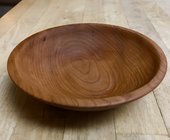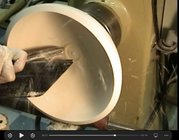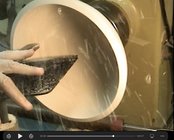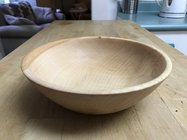One thought I have as I imagine I am watching you turn your bowl, is that it's hard to enter the cut when you are a beginner. On this bowl, I have the impression that you went 'straight in' for about a half inch, maybe 3/4", and then started to follow the outside curve (which you did quite well). That half inch is longer than Al Hockenbery by about 7/16 of an inch.
Suggestions:
1. It's hard to enter the cut if the surface of the bowl is rough. Facing off (smoothing) the surface face of the blank is generally the first step in hollowing the inside. When you get to the last hollowing cuts, you should have what will be the remaining rim of the bowl finished smooth.
2. In order to enter the cut, as you apparently know, you need to have the bevel pointing parallel with the lathe axis. If you have any angle to it, you'll get a skate. One method that works well as you are learning to turn is to make a little notch or shelf where you will start the next cut. You do this with a parting tool, as Brian describes, but on your last cut, that will leave a rougher corner than this method: by turning the gouge with the flute toward the outside, and moving it from inside to outside, with just a 1/16" of the edge cutting the wood, cut that little notch. Either way, you make it, that gives you a 1/16"X1/16" or so stable, safe, skate free place to start your next cut, at nearly any angle you choose. The outer edge of the notch keeps your gouge from skating.
Eventually, you will become skilled enough to start your cut by moving the bevel straight in for that 1/16" and then repositioning at the desired angle. Essentially, you are cutting that notch and starting your hollowing cut all in one step.
3. As you're hollowing, from the center of the bowl outwards toward the rim, make your last 3 cuts at calculated depths and curves. That is, at intentional distances from where your bowl side or rim thickness will end up. The 3rd to last cut is at a depth to leave you with an easy 2nd to last cut plus a shallow final cut, and it should be very close to the final inside shape. Then the 2nd to last cut is an easily controlled, comfortable depth, and done to make exactly the shape you want. The Last Cut is thin or shallow, so you have really good control and you avoid or remove tear out. Because you have already established the final shape, the Last Cut can remove a consistent thickness of wood, without you having to steer to correct something. Easy Peasy.
This bowl shows you have learned how to create a nice curve--it's not a dog bowl! As your second, or so, bowl, it's a terrific success. You're improving at a fast pace. Keep it up.
(If anything above is not clearly expressed, I apologize, and you are welcome to ask for clarification, if you think I'm onto something useful)



![Al Hockenbery - Mounting and turning a dried bowl [sCZWsHB4vlM - 1328x747 - 30m06s].png Al Hockenbery - Mounting and turning a dried bowl [sCZWsHB4vlM - 1328x747 - 30m06s].png](https://www.aawforum.org/community/data/attachments/45/45081-3f5e533cdb6736809c5768320ca159a6.jpg)


